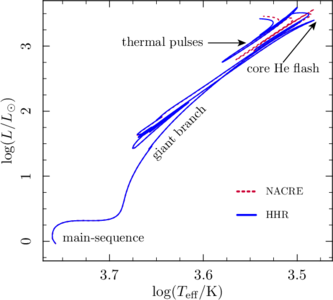
Evolutionary track of a one solar mass star with solar composition from the zero-age main sequence to the AGB phase, as modeled by the MESA stellar evolution code. The two tracks are for the HHR rate (solid blue) and the NACRE rate (dashed red). Although there are small differences during thermally unstable H and He shell burning (”thermal pulses”), there is no difference in the white dwarf’s mass or composition.
Image credit: N.B. Nguyen (JINA/MSU).
The low-temperature triple-alpha rate
The triple-alpha reaction is critical for the production of elements of mass number > 12. The discovery of the resonant capture into the Hoyle state of 12C is one of the triumphs of nuclear astrophysics. As part of her thesis, NSCL graduate student N.B. Nguyen computed a full solution to the three body α+α+α problem and determined the non-resonant reaction rate, which becomes important at temperatures below ≈0.07 GK. Unlike previous extrapolations, the new rate is strongly enhanced at lower temperatures (a factor of 1012 at 0.02 GK). Nevertheless, this new rate is consistent with stellar evolution, as shown in the figure. Further studies on the effect of this rate on explosive nucleosynthesis on white dwarfs and neutron stars is ongoing.